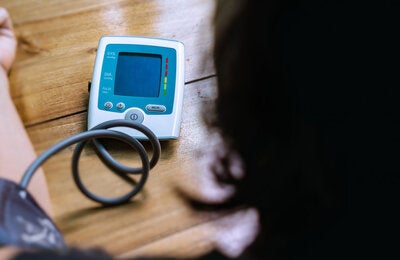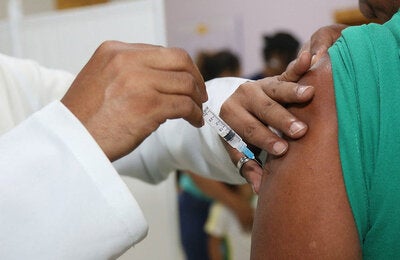

The impact of workplace stress on workers' health and productivity and measures to reduce the problem were the focus of a special webinar organized by the Pan American Health Organization/World Health Organization (PAHO/WHO), the International Labour Organization (ILO), and the Organization of American States (OAS), to mark the World Day for Safety and Health at Work, April 28.
Washington, D.C., 28 April 2016 (PAHO/WHO) — The impact of workplace stress on workers' health and productivity and measures to reduce the problem were the focus of a special webinar organized by the Pan American Health Organization/World Health Organization (PAHO/WHO), the International Labour Organization (ILO), and the Organization of American States (OAS), to mark the World Day for Safety and Health at Work, April 28.
"None of us is a stranger to work stress," said PAHO Assistant Director Francisco Becerra, in opening the webinar. "The world of work today—given the challenges of industrial progress, globalization, technological development and virtual communications--imposes conditions on us that often exceed the limits of our abilities and capabilities. The result is work stress that can lead to physical, mental and even social dysfunctions that damage our health, undermine our productivity and affect our family and social circles."
"Workplace stress: a collective challenge" is the theme of this year's World Day for Safety and Health at Work and the title of a new report on this subject from ILO. The report notes that global data on the prevalence and impact of workplace stress are not available. However studies from the Americas and other regions indicate it is a significant problem. According to a 2012 survey on working conditions and health in Central America, for example, more than 10% of respondents reported having felt constantly under stress or strain, feeling sad or depressed, or losing sleep due to concerns about working conditions.
Similarly, a 2009 survey in Argentina showed 26.7% of workers reported mental stress due to what they considered excessive work loads. In Brazil, a study examining absences due to occupational accidents anddiseases found that 14% of annual health benefits were related to mental illness. And a 2011 survey in Chile found that 27.9% of workers and 13.8% of employers reported stress and depression in their enterprises.
Psychosocial hazards
The most common causes of stress at work are psychosocial hazards related to work organization, work design, working and labor conditions, as well as external conditions that can influence a worker's performance, job satisfaction and health.
Although the impact of workplace stress varies from one individual to another, it is known to produce health consequences ranging from mental illness to cardiovascular, musculoskeletal and reproductive diseases. Workplace stress also causes behavioral problems including alcohol and drug abuse, increased smoking, sedentarism, and sleep disorders.
"These problems are all associated with reduced motivation, satisfaction, commitment and work performance, and increased absenteeism, employee turnover, and early retirement—all of which can lead to diminished productivity and competitiveness and damaged reputations for organizations," said Dr. Julietta Rodriguez, PAHO advisor on workers' health.
Seeking solutions
ILO and WHO have issued guidelines and recommendations to address these problems, including the promotion of workers' empowerment, participation and satisfaction, as well as the adoption of the ILO's "decent work" concept, whose elements include fair employment, respect for human rights, labor standards, environmental protection, transparency and social dialogue. ILO also strongly recommends that countries include stress and mental problems at work in their lists of occupational diseases, to ensure these can be identified, quantified and subsequently addressed.
For its part, PAHO/WHO has also issued recommendations, guidelines and interventions for prevention of mental health problems due to psychosocial risks and has published the series "Protecting workers' health," which promotes policies and measures to minimize exposure to these hazards. According to WHO's 's recommendations, an appropriate, comprehensive workplace policy based on ethical principles should:
- cover all hazardous exposures within the work environment
- apply norms of good behavior, care, and responsibility
- include approaches to prevent unethical behaviors, and to act on them if they occur, and
- promote responsibility and accountability of everyone at the workplace.
"The burden of workplace stress and mental health problems at work point to an urgent need to create and promote healthy workplaces in which physical health, safety and well-being are protected, not harmed," said Kira Fortune, acting chief of PAHO's program on Sustainable Development and Health Equity.
Country experiences
Participants in the webinar included representatives of the mnistries of labor of Colombia and Mexico as well as delegates from the OAS Trade Technical Advisory Council (COSATE) and the Business Technical Advisory Committee on Labor Matters (CEATAL). They described their efforts to address workplace stress and related problems.
Colombia has, since 2004, had guidelines for assessing psychosocial risks at work and recently developed a series of protocols to address the problem in general as well as in specific economic sectors.
Mexico designed a strategy to promote healthy work settings that are free of violence, that address psychosocial factors, and that promote emotional well-being to generate healthy work habits. The strategy includes measures to help older workers prepare for retirement, to enhance savings for young workers, to coach workers diagnosed with emotional disorders, and to promote work and human development. The strategy is being promoted through active social dialogue, consensus mechanisms, and research and training.
Links



